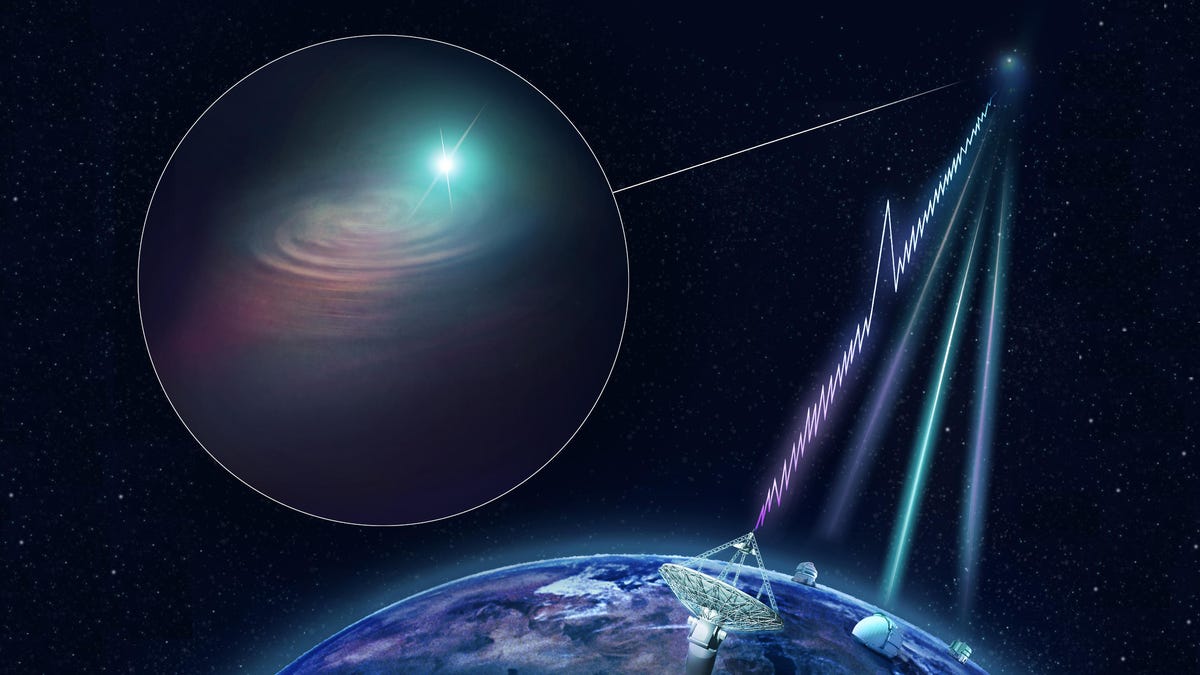Astronomers discover the source of unexplained cosmic radio burst
A mysterious, one-off radio burst was received from deep-space in September 2018. Now we know where it came from.

To discover the source of a one-off, mysterious space signal, an international team of astronomers utilized telescopes around the world.
Astronomers keep hearing unexplained, incredibly powerful signals from the far reaches of space -- signals that come through loud and clear for a thousandth of a second and then mysteriously disappear. First discovered in 2007, "these pulses are known as fast radio bursts", and they remain one of the universe's biggest mysteries. Dozens of the enigmatic cosmic signals have been detected, and astronomers have puzzled over them for the past decade, trying to decode where they come from -- and what causes them.
In a historic first, an international team of researchers have pinpointed the location of a non-repeating fast radio burst, finding its source originates in the outskirts of a galaxy 4 billion light-years away.
The monumental findings, published in AAAS journal Science on Thursday, detail the discovery and localization of FRB 180924, a powerful, one-off fast radio burst that lasted for just a fraction of a second. Speculation about the cause of the bizarre signals takes in everything from explosive neutron stars to alien spacecraft, and while we're still not sure what's causing them, the revelation puts astronomers one step closer to their true nature.
"This is the big breakthrough that the field has been waiting for since astronomers discovered fast radio bursts in 2007," said Keith Bannister, lead author of the paper and principal research engineer with Australia's Commonwealth Scientific and Industrial Research Organisation.
The burst was picked up by the Australian Square Kilometre Array Pathfinder, which consists of 36 radio telescopes working in tandem to scan the sky and listen for radio signals. Situated in the Australian outback, where there's little radio interference, ASKAP is able to pick up the faintest whispers of the universe. The burst traveled from the other side of the universe, smacking into ASKAP's array -- and within half a second, the machine stopped the search and downloaded the data from each of the 36 dishes.
The burst hits each dish at slightly different times. In a ridiculous feat of engineering, the team can calculate the difference in arrival time to within one-tenth of a nanosecond. That allows their detective work to begin, tracing the position to a spot in the sky -- essentially plucking a needle from a haystack.
The research team found FRB 180924 had come from a distant galaxy very similar in size to our own Milky Way. Galaxies are huge, huge swirling masses of stars, but the team was able to pinpoint the burst's exact cosmic city block, approximately 13,000 light-years from the center of the galaxy.
The view from antenna 29 of the the Australian Square Kilometre Array Pathfinder as it listens for deep-space signals.
After locating the burst, the research team used a suite of other telescopes around the world, including the Very Large Telescope and the Gemini South telescope in Chile, as well as the Keck telescope in Hawaii. Getting these extra cosmic eyes trained on the spot allowed the team to further characterize the location.
On only one other occasion, in 2017, has a fast radio burst been traced to its source -- and that particular investigation was slightly easier because the burst repeated itself intermittently, like a strobe light. Known as FRB 121102, or the "repeater," the burst came from a completely different source to FRB180924: a dwarf galaxy slightly around 3 billion light-years away.
"The burst we localized and its host galaxy look nothing like the 'repeater' and its host," said Adam Deller, an astrophysicist at Swinburne University of Technology.
That suggests non-repeating fast radio bursts might be different from those that do repeat, or it could hint that the signal differs depending on where it comes from.
"The evidence certainly points to FRBs living in a very wide range of environments. In that sense, it isn't surprising that their bursting properties, whether they repeat or not, would vary widely too," said Bannister.
It's one thing to locate the signal, but it lies so far away from the Earth that it's impossible for us to see exactly what's causing it. For ASKAP, this is only the beginning. Bannister notes that the group is "almost fully armed and operational," and he expects to localize more radio bursts in the future.
"We're continually extending the capabilities of the telescopes and getting better at finding the needles in the haystack," adds Deller.
With all manner of fantastic explanations put forward for the rare cosmic signals -- magnetars, neutron stars and aliens -- Bannister isn't ruling out extraterrestrial intelligence just yet.
"I think in all likelihood we'll work out a natural explanation for these events, but I like to keep an open mind and follow wherever the evidence leads me."
Updated 3:15 p.m. PT: Added extra comments from researchers

